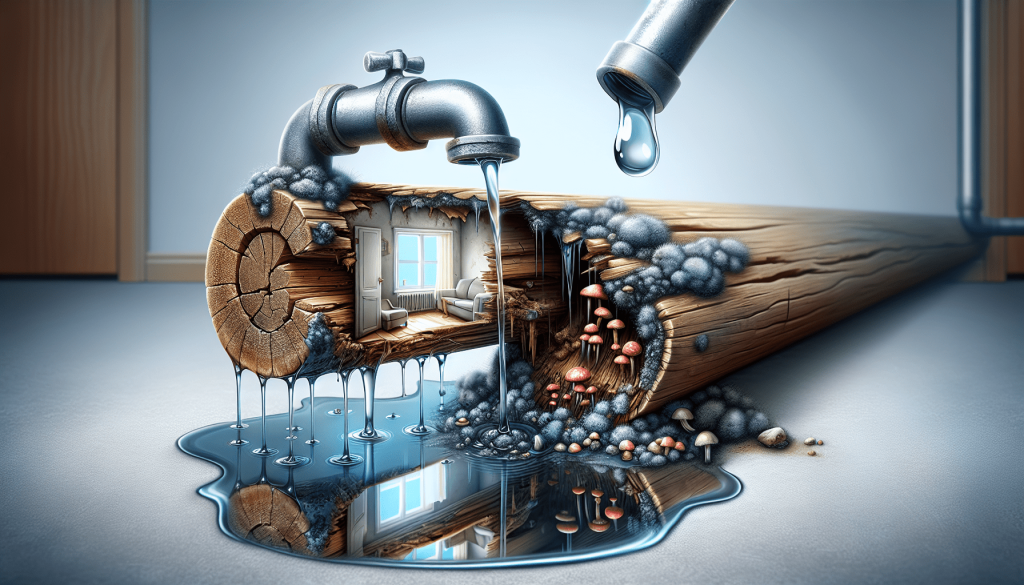In our latest video, titled “Uncovering the Damage: Small Water Leaks and Their Consequences,” we take a closer look at the extent of damage that can be caused by a seemingly harmless water leak. Focusing on a particular water heater leak, we reveal how it weakened the wooden platform, causing the heater to lean against the wall. This allowed water to leak into the wall, resulting in toxic mold and significant damage. The video provides a detailed analysis of the problems caused by small water leaks, from discoloration to rusting and mold growth, ultimately highlighting the importance of addressing these issues promptly.
Stay tuned for our upcoming video where we will delve deeper into the potential consequences of a small water leak and provide further insights into water heater problems.

The Consequences of Small Water Leaks
1. Introduction to Small Water Leaks
Water leaks, no matter how small, can have serious consequences for homeowners. From damage to the water heater platform to the growth of toxic mold, these leaks can cause significant structural damage and health risks if left unattended. In this article, we will explore the various consequences of small water leaks and discuss the importance of identifying and fixing problem areas.
2. Damage to the Water Heater Platform
One of the first areas that can be affected by a small water leak is the wooden platform on which the water heater sits. Over time, the constant exposure to water can weaken the platform, compromising its structural integrity. This can lead to sagging or even collapsing of the platform, posing a safety hazard. Additionally, the weakened platform can also cause the water heater to lean up against the wall, further exacerbating the potential for water leakage.
2.1 Weakening of the Wooden Platform
The constant presence of water caused by a small leak can gradually weaken the wooden platform supporting the water heater. The moisture can penetrate the wood, causing it to rot and become structurally unsound. This weakening may not be immediately noticeable, but over time, it can lead to sagging or even complete failure of the platform. It is essential to regularly inspect the platform for any signs of weakness to prevent accidents or further damage.

2.2 Leaning of the Water Heater
As the wooden platform weakens, the water heater may begin to lean up against the wall. This can occur due to the loss of support from the deteriorating platform. When the water heater leans, it may put pressure on the surrounding pipes, increasing the risk of further leaks and damage. Additionally, the leaning position can make it more challenging to access and repair the water heater, complicating the process of fixing the initial leak.
3. Water Leaks and Mold Growth
One of the most significant consequences of water leaks is the growth of mold, especially when it comes to small leaks from water heaters. The excess moisture creates the ideal breeding ground for mold spores to develop and thrive. Mold can spread rapidly, not only on the water heater platform but also into surrounding walls and other parts of the house. It can pose serious health risks, particularly in the case of toxic mold.

3.1 Toxic Mold and its Implications
Toxic mold, often referred to as black mold, can release harmful mycotoxins that can cause severe health problems when exposed to for prolonged periods. These health issues can range from allergic reactions, respiratory problems, to more severe conditions such as chronic sinus infections or even neurological damage. Identifying and addressing water leaks promptly is crucial to prevent the growth of toxic mold and protect the well-being of occupants.
3.2 Discoloration as a Clue for Water Leaks
One way to identify potential water leaks is through discoloration on various surfaces around the house. Whether it be wood siding, concrete, floors, or ceilings, any abnormal discoloration should be considered a clue that there may be a problem. Discoloration can indicate the presence of moisture, which is often a sign of an underlying water leak. Keeping a vigilant eye out for any unusual spots or stains can help catch leaks early before they cause significant damage.

4. Identifying Problem Areas
In order to prevent the consequences of small water leaks, it is essential to identify and address problem areas promptly. Regular maintenance and inspection of water heaters and their surroundings can help detect leaks before they worsen. Look for any signs of discoloration, mold growth, or weakening structures. Additionally, keep an eye out for any unusual odors or sounds, which may also indicate a leak. Prompt action can save homeowners from costly repairs and protect their health and safety.
6. Conclusion
Small water leaks can have significant consequences for homeowners if left unattended. From damaging the water heater platform to fostering the growth of toxic mold, the impact can be far-reaching. By understanding the potential risks and recognizing the signs of water leaks, homeowners can take proactive measures to prevent further damage and maintain a safe and healthy living environment. Regular maintenance and inspections are key to keeping water leaks at bay and ensuring the longevity of both the water heater and the surrounding structures.


